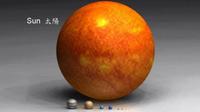The Sun is a seething ball of gas, powered by nuclear reactions in a central core with a temperature of over 10 million degrees Kelvin.
Even though the diameter of the sun is about 400 times that of the moon, and it out-masses the moon by about 27 million times, they are both approximately the same apparent size in our sky
The several- days-long flight of the various Apollo missions in the ’60s and ’70’s would not even get them to two-thirds of the Sun’s radius, assuming that they started at the center.
It contains more than 99.8% of the total mass of the Solar System
Relating the size of the Solar system to familiar objects can make it easier for students to grasp the relative distances. Most classroom globes are 41 cm (16 inches) in diameter. If the Earth were reduced to this size, the Moon would be a 10 cm (4 in) baseball floating 12 metres (40 feet) away. The Sun would be a beach ball 14 stories tall (somewhat smaller than the Spaceship Earth ride at Epcot) floating 5 kilometres (3 miles) away.
The Boston Museum of Science has a model of the Solar System, and we’re not talking about a collection of ping-pong balls in a glass case in the museum. This is a really amazing 1-to-400 million scale model (1 inch equals 10,000 km), spread across the wider Boston area.
As the Voyager 1 spacecraft headed out of our Solar System, it looked back and took a parting family portrait of the Sun and planets. From beyond Pluto, our Solar System looks like a bright star surrounded by faint dots
There are 17 bodies in the solar system whose radius is greater than 1000 km.
If the sun consumes “x” amount of mass per second during nuclear fusion, and it is believed to be “y” years old, how big (diameter) was it believed to be when it was first “fired up”?

